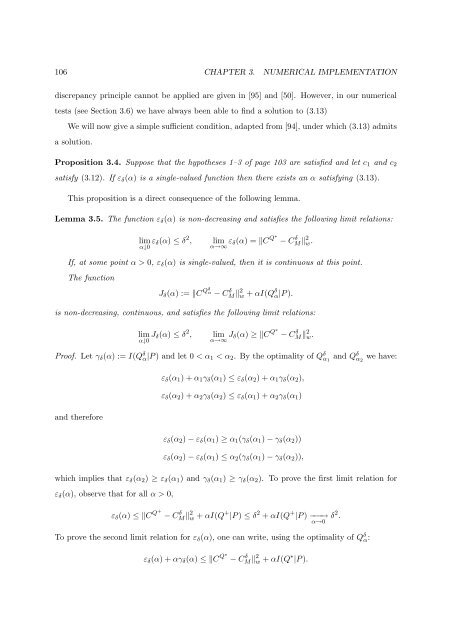Processus de Lévy en Finance - Laboratoire de Probabilités et ...
Processus de Lévy en Finance - Laboratoire de Probabilités et ...
Processus de Lévy en Finance - Laboratoire de Probabilités et ...
You also want an ePaper? Increase the reach of your titles
YUMPU automatically turns print PDFs into web optimized ePapers that Google loves.
106 CHAPTER 3. NUMERICAL IMPLEMENTATION<br />
discrepancy principle cannot be applied are giv<strong>en</strong> in [95] and [50]. However, in our numerical<br />
tests (see Section 3.6) we have always be<strong>en</strong> able to find a solution to (3.13)<br />
We will now give a simple suffici<strong>en</strong>t condition, adapted from [94], un<strong>de</strong>r which (3.13) admits<br />
a solution.<br />
Proposition 3.4. Suppose that the hypotheses 1–3 of page 103 are satisfied and l<strong>et</strong> c 1 and c 2<br />
satisfy (3.12). If ε δ (α) is a single-valued function th<strong>en</strong> there exists an α satisfying (3.13).<br />
This proposition is a direct consequ<strong>en</strong>ce of the following lemma.<br />
Lemma 3.5. The function ε δ (α) is non-<strong>de</strong>creasing and satisfies the following limit relations:<br />
lim ε δ (α) ≤ δ 2 ,<br />
α↓0<br />
lim ε δ(α) = ‖C Q∗ − C δ<br />
α→∞<br />
M‖ 2 w.<br />
If, at some point α > 0, ε δ (α) is single-valued, th<strong>en</strong> it is continuous at this point.<br />
The function<br />
J δ (α) := ‖C Qδ α<br />
− CM‖ δ 2 w + αI(Q δ α|P ).<br />
is non-<strong>de</strong>creasing, continuous, and satisfies the following limit relations:<br />
lim J δ (α) ≤ δ 2 ,<br />
α↓0<br />
lim J δ(α) ≥ ‖C Q∗ − C δ<br />
α→∞<br />
M‖ 2 w.<br />
Proof. L<strong>et</strong> γ δ (α) := I(Q δ α|P ) and l<strong>et</strong> 0 < α 1 < α 2 . By the optimality of Q δ α 1<br />
and Q δ α 2<br />
we have:<br />
and therefore<br />
ε δ (α 1 ) + α 1 γ δ (α 1 ) ≤ ε δ (α 2 ) + α 1 γ δ (α 2 ),<br />
ε δ (α 2 ) + α 2 γ δ (α 2 ) ≤ ε δ (α 1 ) + α 2 γ δ (α 1 )<br />
ε δ (α 2 ) − ε δ (α 1 ) ≥ α 1 (γ δ (α 1 ) − γ δ (α 2 ))<br />
ε δ (α 2 ) − ε δ (α 1 ) ≤ α 2 (γ δ (α 1 ) − γ δ (α 2 )),<br />
which implies that ε δ (α 2 ) ≥ ε δ (α 1 ) and γ δ (α 1 ) ≥ γ δ (α 2 ). To prove the first limit relation for<br />
ε δ (α), observe that for all α > 0,<br />
ε δ (α) ≤ ‖C Q+ − C δ M‖ 2 w + αI(Q + |P ) ≤ δ 2 + αI(Q + |P ) −−−→<br />
α→0 δ2 .<br />
To prove the second limit relation for ε δ (α), one can write, using the optimality of Q δ α:<br />
ε δ (α) + αγ δ (α) ≤ ‖C Q∗ − C δ M‖ 2 w + αI(Q ∗ |P ).
















